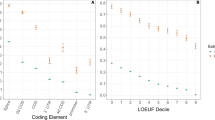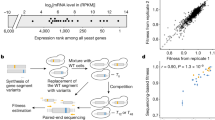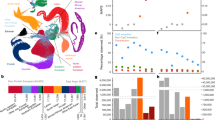Abstract
Mutation hotspots are commonly observed in genomic sequences and certain human disease loci1,2,3,4,5,6,7, but general mechanisms for their formation remain elusive7,8,9,10,11. Here we investigate the distribution of single-nucleotide changes around insertions/deletions (indels) in six independent genome comparisons, including primates, rodents, fruitfly, rice and yeast. In each of these genomic comparisons, nucleotide divergence (D) is substantially elevated surrounding indels and decreases monotonically to near-background levels over several hundred bases. D is significantly correlated with both size and abundance of nearby indels. In comparisons of closely related species, derived nucleotide substitutions surrounding indels occur in significantly greater numbers in the lineage containing the indel than in the one containing the ancestral (non-indel) allele; the same holds within species for single-nucleotide mutations surrounding polymorphic indels. We propose that heterozygosity for an indel is mutagenic to surrounding sequences, and use yeast genome-wide polymorphism data to estimate the increase in mutation rate. The consistency of these patterns within and between species suggests that indel-associated substitution is a general mutational mechanism.
This is a preview of subscription content, access via your institution
Access options
Subscribe to this journal
Receive 51 print issues and online access
$199.00 per year
only $3.90 per issue
Buy this article
- Purchase on Springer Link
- Instant access to full article PDF
Prices may be subject to local taxes which are calculated during checkout



Similar content being viewed by others
References
Hedrich, K. et al. Distribution, type, and origin of Parkin mutations: review and case studies. Mov. Disord. 19, 1146–1157 (2004)
Bonneau, D. & Longy, M. Mutations of the human PTEN gene. Hum. Mutat. 16, 109–122 (2000)
Chi, Y. I. Homeodomain revisited: a lesson from disease-causing mutations. Hum. Genet. 116, 433–444 (2005)
Mortazavi, Y. et al. The spectrum of PIG-A gene mutations in aplastic anemia/paroxysmal nocturnal hemoglobinuria (AA/PNH): a high incidence of multiple mutations and evidence of a mutational hot spot. Blood 101, 2833–2841 (2003)
Iacobuzio-Donahue, C. A. et al. Missense mutations of MADH4: characterization of the mutational hot spot and functional consequences in human tumors. Clin. Cancer Res. 10, 1597–1604 (2004)
Galtier, N., Enard, D., Radondy, Y., Bazin, E. & Belkhir, K. Mutation hot spots in mammalian mitochondrial DNA. Genome Res. 16, 215–222 (2005)
Maki, H. Origins of spontaneous mutations: specificity and directionality of base-substitution, frameshift, and sequence-substitution mutageneses. Annu. Rev. Genet. 36, 279–303 (2002)
Arndt, P. F., Hwa, T. & Petrov, D. A. Substantial Regional Variation in Substitution Rates in the Human Genome: Importance of GC Content, Gene Density, and Telomere-Specific Effects. J. Mol. Evol. 60, 748–763 (2005)
Rogozin, I. B. & Pavlov, Y. I. Theoretical analysis of mutation hotspots and their DNA sequence context specificity. Mutat. Res. 544, 65–85 (2003)
Silva, J. C. & Kondrashov, A. S. Patterns in spontaneous mutation revealed by human-baboon sequence comparison. Trends Genet. 18, 544–547 (2002)
Crow, J. F. The high spontaneous mutation rate: is it a health risk? Proc. Natl Acad. Sci. USA 94, 8380–8386 (1997)
Ellegren, H., Smith, N. G. & Webster, M. T. Mutation rate variation in the mammalian genome. Curr. Opin. Genet. Dev. 13, 562–568 (2003)
Denver, D. R., Morris, K., Lynch, M. & Thomas, W. K. High mutation rate and predominance of insertions in the Caenorhabditis elegans nuclear genome. Nature 430, 679–682 (2004)
Longman-Jacobsen, N., Williamson, J. F., Dawkins, R. L. & Gaudieri, S. In polymorphic genomic regions indels cluster with nucleotide polymorphism: Quantum Genomics. Gene 312, 257–261 (2003)
Petrov, D. A. DNA loss and evolution of genome size in Drosophila . Genetica 115, 81–91 (2002)
Hardison, R. C. et al. Covariation in frequencies of substitution, deletion, transposition, and recombination during eutherian evolution. Genome Res. 13, 13–26 (2003)
Kondrashov, A. S. Direct estimates of human per nucleotide mutation rates at 20 loci causing Mendelian diseases. Hum. Mutat. 21, 12–27 (2003)
Dawkins, R. et al. Genomics of the major histocompatibility complex: haplotypes, duplication, retroviruses and disease. Immunol. Rev. 167, 275–304 (1999)
The Chimpanzee Sequencing and Analysis Consortium. Initial sequence of the chimpanzee genome and comparison with the human genome. Nature 437, 69–87 (2005)
Rat Genome Sequencing Project Consortium. Genome sequence of the Brown Norway rat yields insights into mammalian evolution. Nature 428, 493–521 (2004)
Strickberger, M. S. Evolution (Jones and Bartlett Publishers, 2000)
Lercher, M. J. & Hurst, L. D. Human SNP variability and mutation rate are higher in regions of high recombination. Trends Genet. 18, 337–340 (2002)
Check, E. Human genome: patchwork people. Nature 437, 1084–1086 (2005)
Conrad, D. F., Andrews, T. D., Carter, N. P., Hurles, M. E. & Pritchard, J. K. A high-resolution survey of deletion polymorphism in the human genome. Nature Genet. 38, 75–81 (2006)
Schwartz, S. et al. Human-mouse alignments with BLASTZ. Genome Res. 13, 103–107 (2003)
Thompson, J. D., Higgins, D. G. & Gibson, T. J. CLUSTAL W: improving the sensitivity of progressive multiple sequence alignment through sequence weighting, position-specific gap penalties and weight matrix choice. Nucleic Acids Res. 22, 4673–4680 (1994)
Jukes, T. H. & Cantor, C. R. in Mammalian Protein Metabolism (ed. Munro, H. N.) 21–132 (Academic, 1969)
Ruderfer, D. M., Pratt, S. C., Seidel, H. S. & Kruglyak, L. Population genomic analysis of outcrossing and recombination in yeast. Nature Genet. 38, 1077–1081 (2006)
Acknowledgements
We thank A. Kondrashov (a reviewer) for suggesting the 3-species test and the possibility of a signature for indel-caused substitutions; M. Long and X. Gao for comments; and T. Petes for informing us about genome-wide measures of recombination in yeast. This study was supported by NSFC (30470924, 30470122 & 30570987) and Pre-program for NBRPC (2005CCA02100) to D.T. or J.-Q.C. and by 111 Project.
Author information
Authors and Affiliations
Corresponding authors
Supplementary information
Supplementary Information 1
The file contains extensive Supplementary Information with Supplementary Figures and Supplementary Tables. (PDF 2959 kb)
Rights and permissions
About this article
Cite this article
Tian, D., Wang, Q., Zhang, P. et al. Single-nucleotide mutation rate increases close to insertions/deletions in eukaryotes. Nature 455, 105–108 (2008). https://doi.org/10.1038/nature07175
Received:
Accepted:
Published:
Issue Date:
DOI: https://doi.org/10.1038/nature07175
This article is cited by
-
The evolutionary history of the polyQ tract in huntingtin sheds light on its functional pro-neural activities
Cell Death & Differentiation (2022)
-
Comparative chloroplast genomes: insights into the evolution of the chloroplast genome of Camellia sinensis and the phylogeny of Camellia
BMC Genomics (2021)
-
Evolutionary directions of single nucleotide substitutions and structural mutations in the chloroplast genomes of the family Calycanthaceae
BMC Evolutionary Biology (2020)
-
Insertions and Deletions Play an Important Role in the Diversity of Conotoxins
The Protein Journal (2020)
-
Structural Evolution of the Glacier Ice Worm Fo ATP Synthase Complex
The Protein Journal (2020)
Comments
By submitting a comment you agree to abide by our Terms and Community Guidelines. If you find something abusive or that does not comply with our terms or guidelines please flag it as inappropriate.



